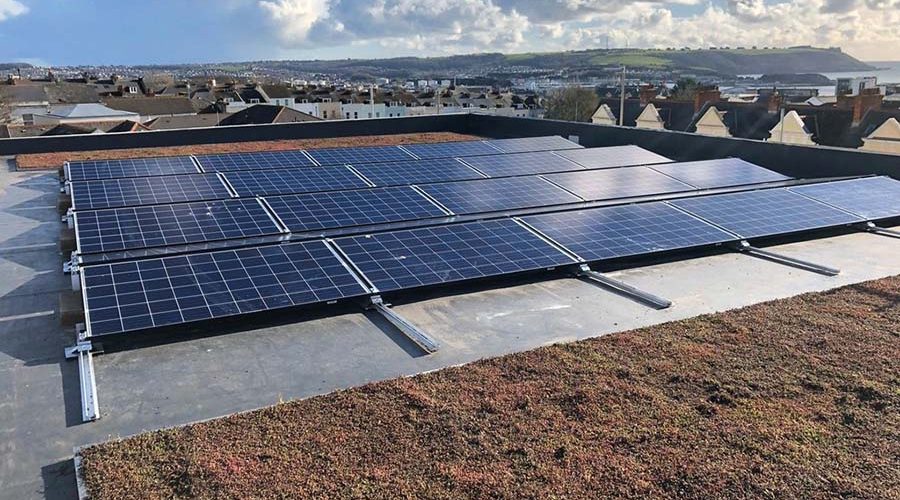Public health and wellbeing are now a major national focus, and with £1bn being set aside by the UK Government as part of a commitment into making homes and public sector buildings more energy-efficient, sustainability within the construction sector is set to play a crucial role in the country’s long-term economic recovery. With the spotlight firmly fixed on energy efficiency for the foreseeable future, there is now an opportunity for the public sector; from schools and healthcare providers to local authorities, to set the sustainable standard; starting by looking up.
DFR Roofing
With a third of a structure’s energy lost through its roof, making small changes can reap big rewards, especially within a sector driven by long-term cost savings. However, with energy costs predicted to rise at an annual rate of 3%, even the smallest of measures to improve a roof’s efficiency will have an enormous impact on energy bills. From upgrading insulation and using trusted contractors, to harnessing the power of sunlight, Andy Pilkington, Director at DFR Roofing, outlines why now is the time to reap the eco-benefits of roofing the easy way, as well as how the public sector can lead the way for a cleaner, more efficient future.
Inside out
The nation’s public sector roofs are often seen as an inconvenience, with a general ‘patch and repair’ approach leaving many in a detrimental state and in desperate need of a full replacement or refurbishment. However, with maintenance budgets continuing to dwindle, only the most urgent of building concerns are likely to be placed at the top of the list. However, providing the opportunity to not only reduce long-term operating expenditures, but also make it pay back into an organisation, making small changes to a roof can result in big benefits.
While the likes of green roofs are often seen as an ‘ideal’ energy-efficient solution; helping to turn over-crowded urban cities into thriving green forests, while improving air quality and lowering build running costs, these are not a ‘one-size-fits-all’ option for every structure and currently are mostly restricted to those with buoyant budgets. Requiring additional structural support and a long-term maintenance plan, for a sector in which finances are already stretched to breaking point, making changes and upgrades to a roof’s basic build-up can make a positive difference to its performance and eco capabilities.
Whether it’s a roofing refurbishment or replacement, each layer of a roof needs to work in conjunction to ensure it is performing to the highest thermal standards. Insulation plays a key part in this mix, and choosing the right warm roof solution is crucial in achieving desired energy savings; and undertaking a thermal upgrade is one of the easiest ways to improve the performance of an existing building.
For buildings with a flat roof, it is possible to leave the current waterproofing system in place, with the new insulation and vapour control layers bonded to the existing substrate; significantly reducing the costs associated with a full roof replacement. However, before determining an approach, it is wise to undertake a roofing survey to understand the make-up of the current roof; with the results informing how best to achieve the desired insulation thickness, while also taking into account roof build elements such as joins and upstands.
Daylight saving
Every roof provides an opportunity to not only save money, but also make money, with the right approach helping to create an efficient building envelope; one which improves the internal environment for occupants. Beyond refurbishments or replacements, there are other ways to make a roof pay, one of which being the installation of roof lights as part of an integrated building approach. Maximising natural daylight without compromising on thermal performance or waterproofing qualities, studies have shown that access to sunlight can also have a positive effect on occupant mood and productivity. Reducing the reliance on artificial lighting, rooflights can also reduce CO2 emissions, while ventilation skylights help to improve internal air circulation and temperature control.
For those looking to really maximise their roof’s earning potential, a solar panel system should be a consideration; especially with installation costs having fallen in recent years, along with the provision of fully-funded packages.
Offsetting energy costs, requiring little maintenance and with diverse applications, the benefits are numerous, however, while often still slightly out of reach for the public sector, solar panels are likely to only become more accessible as building operation costs continue to rise.
Built to last
Assurance matters, and none more so than in the public sector; which is why it’s imperative to specify roofing products and materials which are proven to last. By working with a reputable single manufacturer, who can guarantee their system’s long-term performance, any unseen issues will fall into the manufacturer’s area of responsibility. While sometimes more cost-effective to use multiple suppliers, the drawback is there will likely be multiple points of contact, making it difficult to determine which guarantee comes into question.
The same approach needs to be applied to installation, with its design and planning requiring the utmost precision to ensure longevity and high performance. An expert roofing contractor will work alongside trusted manufacturers and contractors to ensure a roofing system is installed correctly and functions with the rest of the building envelope. They will also be able to manage the removal and installation of solar systems to ensure the build-up of the roof isn’t compromised and all the eco-benefits are achieved.
With roofing technology and methods continuing to rapidly progress, roofs are often the key to a more efficient, economic and eco-friendly future for the public sector; with the right choice helping to reduce energy bills by up to 25%. With budgets only set to become tighter, looking to the roof can be one of the easiest and most efficient ways for the public sector to meet energy targets, setting the sustainable standards for others to follow.















